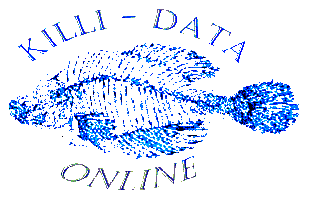KILLI-DATA CATALOGUE 2006
Dear aquarists,
I am extremely pleased to announce the publication of a new (huge) book : "Killi-Data Catalogue" (2006 edition : published on December 10), ISBN : 2-9527283-0-5.
What is it ?
The Catalogue is an (automatic) excerpt of the data base in full colors and with 1028 pages (about 1000 pages for the database part). What similarities and differences with the online database : the listing is alphabetical, each name is followed by 2 color photos (male, female, i.e. more than 1200 color photos in total, laser quality), with all identity data, with all systematic knowledge, with all aquarium breeding and maintenance data, and with a map of distribution… but there are not more than 2 photos per species, there are no research data, there are no collecting locality listings and there are no bibliographic sources, simply for space reasons (already
over 1000 pages!).
Why is it published, while already on Internet and to whom it is best suited?
It has been published so that the online data base exists as an official publication. It is primarily aimed at non Killi-data online members and aquarists who can afford the acquisition (even if it is sold at marginal cost and even if it is cheap compared to the price of both Wildekamp's and Seegers's volumes in total), notably those who want to have a paper book as a reference.
Why didn't you split the book into 3 (like Seegers) or 5 (like Wildekamp) volumes, it would have been cheaper and easier to handle?
This book is not a professionally printed product and it is not aimed to be sold by hundreds (maybe just a few dozens or less… first come, first served, and exclusively highly motivated candidates!) for several reasons : it was decidedly prepared in order NOT to jeopardize Wildekamp's and Seegers's series (then only 1 volume with all names in alphabetical order), it is not designed to be in competition with the online data-base (that competition is hopeless : Internet is continuously updated, it is without comparison cheaper (no charge, online, and it saves trees, and not only in Amazonian and African biotopes of our fish !). Nonetheless those, who have seen it, judged the book as a milestone in killifish edition and a marvellous object ! (and a book remains a book, whatever is the future of the Internet).
What are the detailed contents compared to the Internet data-base?
In comparison to the Internet data-base, no bibliographic references and no collecting localities are given due to space constraints, no detailed data on color patterns and morphology, and only a maximum of 2 color photos per species are shown (1 male and 1 female… versus up to 10 on the web). But, for each name, the identity is complete (including a description diagnosis), the systematic status is detailed, the distribution by country is forwarded (and maps are added) and the full ecological niche is presented (conservation status included), together with tips and full coverage for aquarium breeding and maintenance (aquarium populations are listed).
Will it be published each year?
Not at all. No follow-up is planned except if ICZN code offers simple new rules of e-publication with officially accepted availability contents).
How to obtain it?
Write first an e-mail of enquiry to its author, Dr Jean H. Huber, with mailbox at the end of this page to be sure that there are available copies and to know details for payment (only electronic bank transfers).
Isn't it expensive?
If you guess so, then ask a printer what would be the cost of a 1000+ pages book in full colors and with a small size police character of text (= a lot of ink)!
Where may I have a look to a copy?
B&W complimentary copies have been sent to public libraries linked to international Museums (Paris BNF, London NHM, San Francisco CAS, New York AMNH, Rio de Janeiro UFRJ, Tervuren MRAC, Bonn ZFMK). They should be obtainable after usual administrative indexing by these Institutions, except for Paris where it had to be legally deposited in colors. More conveniently you may have a look at the sample page for a species (click on
+ SAMPLE)
When will I get it?
About 1 month after your money has been credited on my account. Please note that, like all Killi-Data Editions, this is a non profit venture !
What about the other standard publications of Killi-Data ?
They are still alive : the new Pocket Killi-Data 2007 (a yearly small booklet of 32 pages with all names) has been published in February 2007 and is only available through partnering Killifish Associations and local Clubs, and brand new, the book Killi-Data 2007 has been published on 27 February which replaces the previous old 2000 edition (with a fifth language!). Hopefully it will be also distributed by your association (and luckily it holds the same number of species as Killi-Data Catalogue, because no species was described, this year, between December 10 and year end… this means that the localities, index and bibliography, missing in the Catalogue, are actually in the standard book !).
Let's finish to thank all aquarists who cooperated and contributed to Killi-Data over the years or those who sent money to build grants for researchers and new young collectors (already 3000 US$ distributed)… without forgetting the computer guys who wrote the complicated programmes. As an author, undoubtedly, I like these push-button books : so little to do (while keeping French humour!).
Take care of your beloved fish (so difficult to study for us).
Dr Jean Huber, Paris, December 10. 2006, updated March 1. 2007, January 1. 2020.


